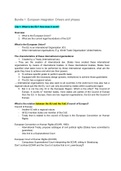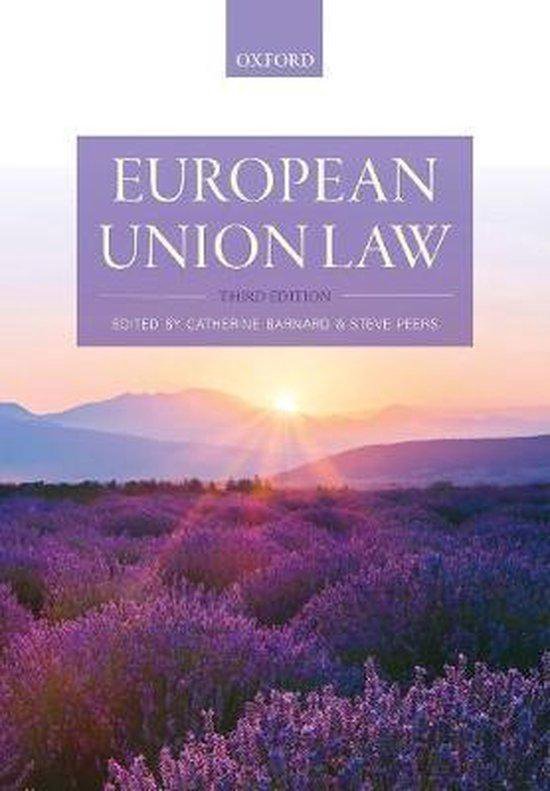Bundle 1: European integration: Drivers and phases
Clip 1: What is the EU? How does it work?
Overview
1. What is the European Union?
2. What are the current legal foundations of the EU?
What is the European Union?
- The EU is an International Organisation (IO)
- Other international organisations, E.g. World Trade Organisation/ United Nations
The characteristics of these international organisations:
1. Created by a Treaty (international law)
→ They are the creation of international law. States have created these international
organisations by means of international treaties. In these international treaties, States have
specified what tasks have to be performed by these international organizations, what are the
goals they have to achieve and what are their powers.
2. To achieve specific goals/ to perform specific tasks
3. Equipped with the necessary design (powers, institutions) to achieve those goals/tasks
4. The EU has a regional nature
→ International organisations may also open to all countries in the world but it may also has a
regional nature just like the EU, so it can only be joined by states within a particular region
5. But it is not the only IO in the European Region. Which is the other? The Council of
Europe. It counts 47 member states, more states are parties of the Council of Europe
than the EU. In Europe, there are two regional organisations, the EU and the Council of
Europe.
What is the relation between the EU and the CoE (Council of Europe)?
Council of Europe
- Another IO with a regional nature
- All EU member states are member of the CoE
- Treaty that is related to the council of Europe is the European Convention on Human
Rights
European Convention on Human Rights (ECHR, 1950)
- International Treaty, propose catalogue of civil political rights (States have committed to
guarantee)
- Also link to a Supranational Court
European Court of Human Rights (ECtHR)
- Compulsory Supranational Court interpreting the ECHR, sitting in Strasbourg
Don’t confuse ECtHR and the Court of Justice that is in Luxembourg!!!
,What are the current legal foundations of the EU?
EU primary legal sources
- How does the EU work? (institutions, goals, principles, policy areas)
- How can the EU validly produce and enforce legal norms?
These are all set up in the treaty.
Currently, the EU is based on The Lisbon Treaty (2 treaties -- same legal value) [EU Primary
Law]
- Signed 13 December 2007, entered into force 1 December 2009
We basically mean:
- Treaty on EU (TEU)
- Treaty on the Functioning of the EU (TFEU)
Together with these treaties, we also refer to
- + Protocols to the Treaty of Lisbon (1-37)
When the Treaty of Lisbon was signed and came into force, also came into force with
- Charter of Fundamental Rights of the EU (CFR)
Treaty on EU (TEU)
- Contains General Provisions
- E.g. Democratic principles, EU principles, Institutions, Enhanced cooperation, External
action
Treaty of the Functioning of the EU (TFEU)
- Specific provisions
- Rules on EU competences, Functioning of institutions, EU citizenship, Policies, Decision
making
Protocols to the Treaty of Lisbon
- Legal value? You have to look at it as footnotes to the treaties
- As ‘footnotes’, interpretative tools
- Specify certain notions that are used in the treaties
Charter of Fundamental Rights of the EU (CFR)
- Written Bill of Rights for the EU
- Currently the same value as the other Treaty [see art. 6(1) TEU]
- Must be considered as EU primary law
- Created in 2000 → Became Hard law with the Lisbon Treaty
- Outcome of a process of ‘Codification’
Before the CFR was created?
- Already individual rights in CJEU’s Case law. The Court of Justice was already
interpreting fundamental human rights in the EU, to do so, was referring to the general
principles of European Union law and the common principles that were shared by all
European member states.
,Before the Lisbon Treaty?
- CFR was used as an instrument of soft law (interpretative tool)
- Used by the national court, the court of justice to interpret EU law in a way that was in
line with the protection of fundamental human rights
- After the Lisbon Treaty, the Charter has the same value as the Treaty
Scope of Application
- **The CFR applies only when EU law is applicable (e.g. when MS implement EU law)
[see art. 51 CFR]
- The Charter is not meant to increase the confidence of the EU and applies to the EU
institutions or member states when they are implementing European Union law
Is there a relation between EU law (CFR) and the Council of Europe (ECHR) ?
Both these international organisations do have a link with an international treaty or with a
document that consists of a catalogue of civilian political rights
E.g. For the EU, we have CFR
E.g. For the Council of Europe, we have European Convention on Human RIghts (as a treaty)
The relation between the two catalogs of rights?
This is relevant even though all the member states in the EU are also members of the Council of
Europe. They are committed to protect the rights as they are set out in both catalogues.
The European Convention on Human Rights (as an international treaty that is linked to the
Council of Europe) is NOT EU LAW!!, not a legal act of the EU.
- There is a reference to EU law tho. Future Accession (?), see art. 6(2) TEU. It said that
rights mentioned in the ECHR are also considered as a source of European law.
Principles that are shared in the systems of all EU states.
- Fundamental Rights as guaranteed in the ECHR and in MS constitutional system are
general principles of EU law
- Interpretation Charger Fundamental Rights must not lowering the standards of protection
that is set in the ECHR as interpreted by the European Court of Human Rights, which
means interpretation even by the Court is the minimum standard below which is not
possible for the Court of Justice to interpret the Charter of Fundamental Rights [see 53
CFR]
, Video 2: Origin and Drivers of EU integration?
Overview
- Origin and Drivers of European Integration (What are the drivers to push the states to
create a EU in the first place?)
- European Integration in 3 words that can describe the process of European integration
Why did states create the EU in the first place?
The ‘EU’ project ¼ (Origins and Drivers of EU integration)
The two faces of Nationalism:
19th century: Unification Nation States (Germany -- Italy)
Nationalism
(Push towards unification, prior boundaries... Too small!)
Nationalist has been the force to push the states to create forms of more complex political
organisations. However, this gave rise to violent conflicts --World War
20th century: National Conflicts on a world scale: WWI and WWII
Prevent World Wars from happening again, the solution would be creating supranational
organisations. Many other international organisations are created too, e.g. UN (achieve
international security). Council of Europe (states in Europe have to commit to the Catalogue of
political and civil rights to prevent the minorities from suffering crimes that were committed
during the WWII.
This is the context where the European Project started.
Goal: Long-Lasting Peace
Strategy: Supranational
1945: UN → International level
1950: ECHR → Supranational Regional Level
The EU project 2/4
1951: European Coal and Steel Community (ECSC)
- 6 member states (Germany, France, Italy, Belgium, Netherlands and Luxembourg)
decided to create the European Coal and Steel Community, a supranational organisation
that was managing resources, e.g. steel and coal
- Supranational management of strategic resources
1950-4: European Defense Community (EDC)
European Political community (EPC)
- Common foreign policy/ European legislative body (Federation)
- Initially they wanted to create a federation. However, states were not yet ready to give up
their sovereignty. EDC and EPC Failed!! But this does not mean that the 6 founding
states gave up to the idea of creating an international organization with the purpose of
guaranteeing a stronger political integration on the continent and a political community in






